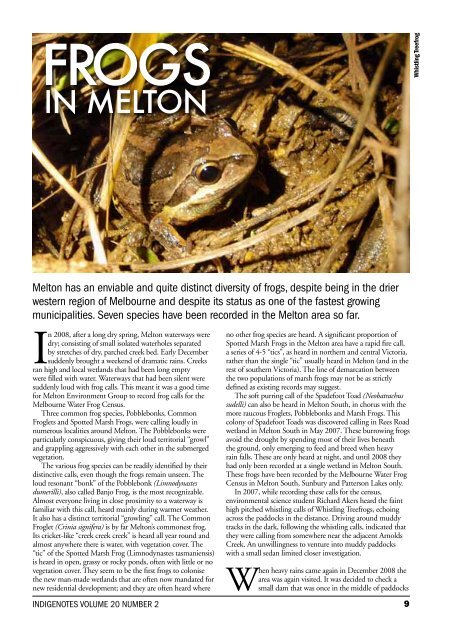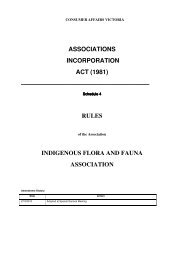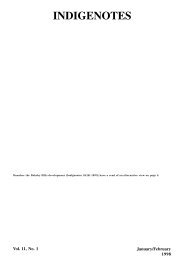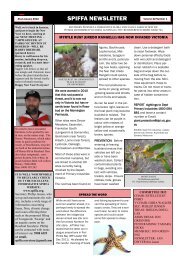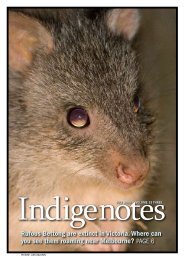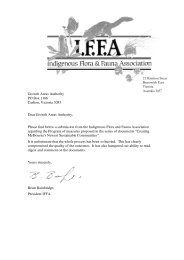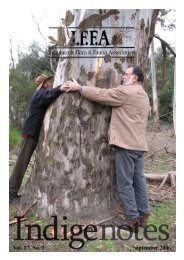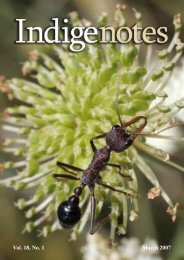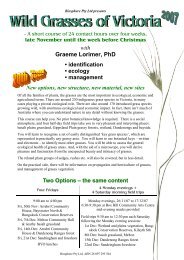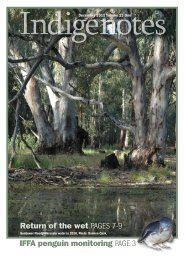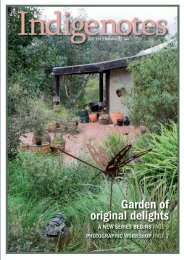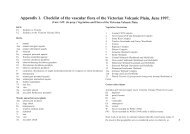July 2009 Volume 20 Two - Indigenous Flora and Fauna Association
July 2009 Volume 20 Two - Indigenous Flora and Fauna Association
July 2009 Volume 20 Two - Indigenous Flora and Fauna Association
You also want an ePaper? Increase the reach of your titles
YUMPU automatically turns print PDFs into web optimized ePapers that Google loves.
Frogs<br />
in Melton<br />
Whistling Treefrog<br />
Melton has an enviable <strong>and</strong> quite distinct diversity of frogs, despite being in the drier<br />
western region of Melbourne <strong>and</strong> despite its status as one of the fastest growing<br />
municipalities. Seven species have been recorded in the Melton area so far.<br />
In <strong>20</strong>08, after a long dry spring, Melton waterways were<br />
dry; consisting of small isolated waterholes separated<br />
by stretches of dry, parched creek bed. Early December<br />
suddenly brought a weekend of dramatic rains. Creeks<br />
ran high <strong>and</strong> local wetl<strong>and</strong>s that had been long empty<br />
were filled with water. Waterways that had been silent were<br />
suddenly loud with frog calls. This meant it was a good time<br />
for Melton Environment Group to record frog calls for the<br />
Melbourne Water Frog Census.<br />
Three common frog species, Pobblebonks, Common<br />
Froglets <strong>and</strong> Spotted Marsh Frogs, were calling loudly in<br />
numerous localities around Melton. The Pobblebonks were<br />
particularly conspicuous, giving their loud territorial “growl”<br />
<strong>and</strong> grappling aggressively with each other in the submerged<br />
vegetation.<br />
The various frog species can be readily identified by their<br />
distinctive calls, even though the frogs remain unseen. The<br />
loud resonant “bonk” of the Pobblebonk (Limnodynastes<br />
dumerilli), also called Banjo Frog, is the most recognizable.<br />
Almost everyone living in close proximity to a waterway is<br />
familiar with this call, heard mainly during warmer weather.<br />
It also has a distinct territorial “growling” call. The Common<br />
Froglet (Crinia signifera) is by far Melton’s commonest frog.<br />
Its cricket-like “creek creek creek” is heard all year round <strong>and</strong><br />
almost anywhere there is water, with vegetation cover. The<br />
“tic” of the Spotted Marsh Frog (Limnodynastes tasmaniensis)<br />
is heard in open, grassy or rocky ponds, often with little or no<br />
vegetation cover. They seem to be the first frogs to colonise<br />
the new man-made wetl<strong>and</strong>s that are often now m<strong>and</strong>ated for<br />
new residential development; <strong>and</strong> they are often heard where<br />
no other frog species are heard. A significant proportion of<br />
Spotted Marsh Frogs in the Melton area have a rapid fire call,<br />
a series of 4-5 “tics”, as heard in northern <strong>and</strong> central Victoria,<br />
rather than the single “tic” usually heard in Melton (<strong>and</strong> in the<br />
rest of southern Victoria). The line of demarcation between<br />
the two populations of marsh frogs may not be as strictly<br />
defined as existing records may suggest.<br />
The soft purring call of the Spadefoot Toad (Neobatrachus<br />
sudelli) can also be heard in Melton South, in chorus with the<br />
more raucous Froglets, Pobblebonks <strong>and</strong> Marsh Frogs. This<br />
colony of Spadefoot Toads was discovered calling in Rees Road<br />
wetl<strong>and</strong> in Melton South in May <strong>20</strong>07. These burrowing frogs<br />
avoid the drought by spending most of their lives beneath<br />
the ground, only emerging to feed <strong>and</strong> breed when heavy<br />
rain falls. These are only heard at night, <strong>and</strong> until <strong>20</strong>08 they<br />
had only been recorded at a single wetl<strong>and</strong> in Melton South.<br />
These frogs have been recorded by the Melbourne Water Frog<br />
Census in Melton South, Sunbury <strong>and</strong> Patterson Lakes only.<br />
In <strong>20</strong>07, while recording these calls for the census,<br />
environmental science student Richard Akers heard the faint<br />
high pitched whistling calls of Whistling Treefrogs, echoing<br />
across the paddocks in the distance. Driving around muddy<br />
tracks in the dark, following the whistling calls, indicated that<br />
they were calling from somewhere near the adjacent Arnolds<br />
Creek. An unwillingness to venture into muddy paddocks<br />
with a small sedan limited closer investigation.<br />
When heavy rains came again in December <strong>20</strong>08 the<br />
area was again visited. It was decided to check a<br />
small dam that was once in the middle of paddocks<br />
INDIGENOTES VOLUME <strong>20</strong> NUMBER 2 9


